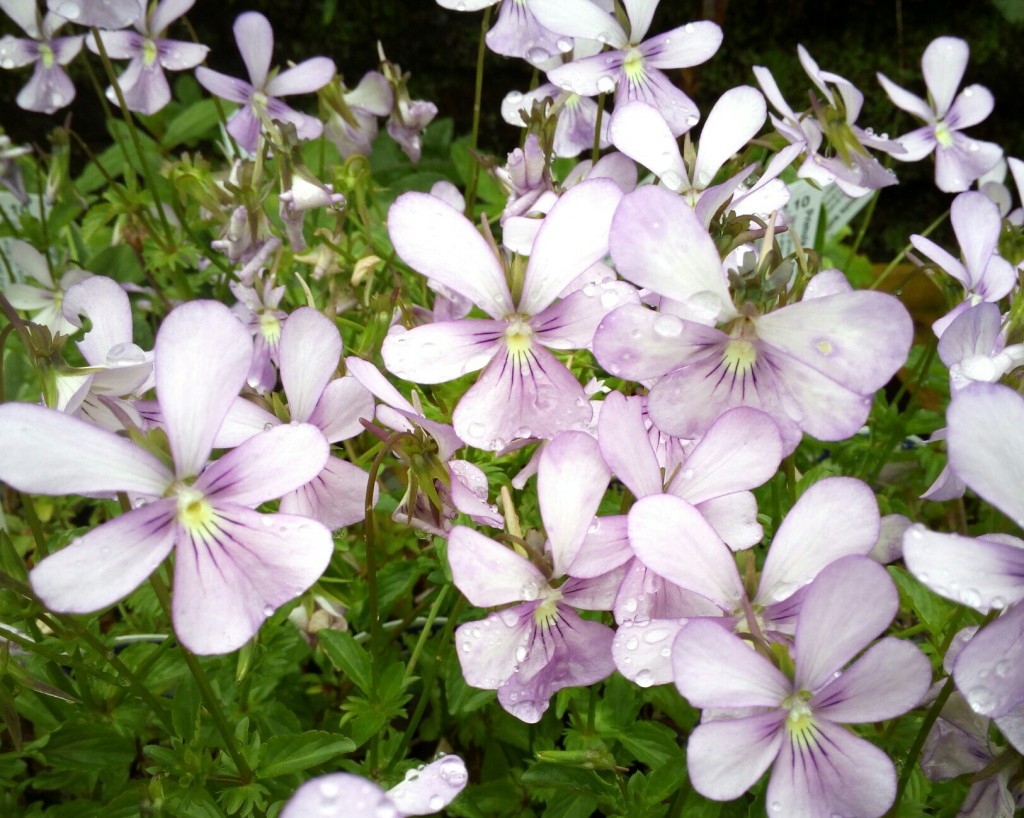Every so often you accidentally stumble across a new and very special plant, one which you had no interest in or awareness of, but which you quickly come to question how you ever lived without it.
Picture the scene; I was at a nursery looking for a load of plants for a customer’s garden when I stepped back and almost damaged a pot behind. As I turned I first saw a strip of nodding blue Viola flowers, almost dense enough to be called a ‘carpet’ of blooms. Now I’m not sure what it was that made the connection; was it the china blue of the flowers, the pointed petals or the sheer floriferousness of the variety? Whatever it was I knew I had to give this plant a try.
Wild Viola cornuta is found predominantly in the Pyrenees (and occasionally in the Alps), and is reliably perennial. Along with Viola tricolor, V. lutea and V, gracilis it has been instrumental in the development of pansies, violas and violettas suitable for garden use. The common name of ‘horned violet’ comes from the long, thin top petals of this species (although it’s worth mentioning that the whole flower is fairly slender).

The Viola I met on that fateful trip to the nursery was called ‘Belmont Blue’ (syn. V. ‘Broughton Blue’). Since that initial meeting I have been keen to get this into as many gardens as possible, and so far everyone who has one has been very pleased with it. I’ve been planting this little gem in cool, rich soil with partial shade; it seems less than keen on being hot and dry, and in fact it would seem that in the hotter parts of the UK it loses its almost perpetual flowering. The late Christopher Lloyd grew V. cornuta at Great Dixter.
Viola cornuta is a true perennial and a superb blender. Backing one patch of it, I have a specimen of the grey-leaved shrub Brachyglottis (syn. Senecio) ‘Sunshine’, and the Viola interlaces with this, flowering with its companion’s grey foliage as a foil and looking at its best in May. After that I usually do a bit of slashing, feed the plants and water them, and off they go again, flowering profusely in the autumn. In a really damp and shady position, however, the Viola, especially in its shining white form, gets better and better right through the season without any treatment. It can be allowed to go to seed and establish itself with any herbaceous plant or low shrub of equal or greater vigour near a border’s margin, and the Viola will sometimes climb 2ft/60cm in order to find the light. Another example of where the white Viola has put itself is with the dwarf, 3ft/90cm bamboo Pleioblastus auricomus, whose foliage is striped yellow and green. As both plants have a slightly creeping habit*, you can’t say where one begins and the other ends.
The Well Tempered Garden (New Edition) by Christopher Lloyd.
* The Pleioblastus can be a thug, but if Lloyd had it “slightly creeping” this could be a) due to very dry soil, or b) because the bamboo was being cut down every year or so, which not only keeps the foliage at its best but also strongly inhibits its spread. I know, off topic, but probably worth mentioning…
The ‘shining white form’ Lloyd mentions is the cultivar most often seen as V. cornuta ‘Alba’, a pure white version of the blue. Despite various attempts I’ve not yet managed to get hold of this cultivar but that’s not for the want of trying.
Increasingly there has been a pink form called V. cornuta ‘Victoria’s Blush’ around in nurseries. This cultivar is typically more compact than ‘Belmont Blue’, making a neat mound rather than the rambling habit of the blue. As with the blue, however, it really doesn’t want to stop flowering in a partly shaded spot!

What has surprised me doing some background reading for this blog is just how many forms of V. cornuta are around, all of which have the potential to be useful garden plants. In volume 2 of Jelitto and Schacht’s superb work ‘Hardy Herbaceous Perennials’ there are many listed as ‘important’, with colours ranging from blues and purples, violets and pinks, reds and yellows. What’s not clear is how many of these forms are still in cultivation, after all my copy of this work is the 2001 reprint, so some of the cultivars listed might have been superseded or even lost.
Viola cornuta seems happiest in partial shade and in a deep, humus rich soil. Although it loves its moisture it will not tolerate being waterlogged. It is absolutely superb in pots, especially under shrubs or larger perennials.

